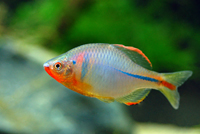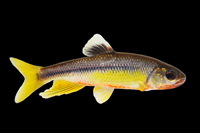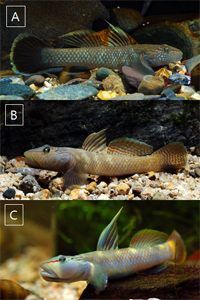|
RESEARCH
Our
ongoing research project can be grouped
into four research areas.
1.
Sexual
selection and genetic quality
 We
focus on mate choice, parental behavior
and the genetic architecture of fitness
(i.e. additive and non-additive genetic
effects) in bitterling, stickleback and
gobies. We are also interested in genetic
compatibility and the interacting effects
of male and female genotypes (i.e. major
histocompatibility complex) on various offspring
fitness. The results obtained from this
research area can be utilized to upgrade
current conservation protocols, where selection
pressure is minimized and individuals may
be coerced to reproduce with non-optimal
mates in captivity. We
focus on mate choice, parental behavior
and the genetic architecture of fitness
(i.e. additive and non-additive genetic
effects) in bitterling, stickleback and
gobies. We are also interested in genetic
compatibility and the interacting effects
of male and female genotypes (i.e. major
histocompatibility complex) on various offspring
fitness. The results obtained from this
research area can be utilized to upgrade
current conservation protocols, where selection
pressure is minimized and individuals may
be coerced to reproduce with non-optimal
mates in captivity.
2.
Metapopulation
genetics
 Assessing
the contribution of various within-drainage
processes to intraspecific genetic structure
remains a major challenge in population
biology. Using population genetic data analysis
including Bayesian and coalescent approaches,
we conduct studies about demographic and
dispersal dynamics among local populations
in Korean chub and splendid dace to gain
insight into contemporary and historical
micro-evolutionary processes in Korean freshwater
systems. Assessing
the contribution of various within-drainage
processes to intraspecific genetic structure
remains a major challenge in population
biology. Using population genetic data analysis
including Bayesian and coalescent approaches,
we conduct studies about demographic and
dispersal dynamics among local populations
in Korean chub and splendid dace to gain
insight into contemporary and historical
micro-evolutionary processes in Korean freshwater
systems.
3.
Contemporary
evolution
 Human
footprint is now widespread in all the ecosystems.
Construction of large structure in many
watercourses and invasive species are among
the anthropogenic changes that have had
the most profound ecological and evolutionary
consequences. The aim of this research is
to understand the particular roles and impact
of anthropogenic factors such as man-made
structures and species invasion on the genetic
structure of freshwater populations as well
as the genetic basis of local adaptation. Human
footprint is now widespread in all the ecosystems.
Construction of large structure in many
watercourses and invasive species are among
the anthropogenic changes that have had
the most profound ecological and evolutionary
consequences. The aim of this research is
to understand the particular roles and impact
of anthropogenic factors such as man-made
structures and species invasion on the genetic
structure of freshwater populations as well
as the genetic basis of local adaptation.
4.
Discovery
of biodiversity – cryptic species
 As
the genetic differentiation is not always
be accompanied by substantial phenotypic
change, cryptic species - animals that appear
identical but are genetically quite distinct
- may be widespread in animals and plants
all over the world, and contemporary count
of nominal species is not likely to be an
appropriate way to estimate our planet’s
biodiversity. We study with Korean chub
and gobiid species to provide insights
into the natural pressures influencing the
birth of new species, and more importantly,
have key implications in conservation biology
ranging from management planning to resource
protection. As
the genetic differentiation is not always
be accompanied by substantial phenotypic
change, cryptic species - animals that appear
identical but are genetically quite distinct
- may be widespread in animals and plants
all over the world, and contemporary count
of nominal species is not likely to be an
appropriate way to estimate our planet’s
biodiversity. We study with Korean chub
and gobiid species to provide insights
into the natural pressures influencing the
birth of new species, and more importantly,
have key implications in conservation biology
ranging from management planning to resource
protection.
|